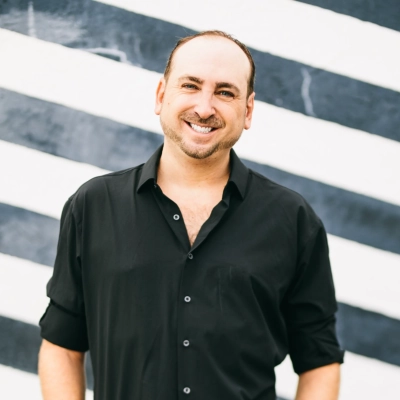23 Advertising Tips for Small Businesses On a Budget
Discover effective advertising strategies for small businesses with limited budgets. This comprehensive guide offers expert-backed tips to maximize your marketing efforts without breaking the bank. From leveraging social media for organic growth to implementing targeted campaigns, learn how to make every advertising dollar count.
- Focus on Strategy Over Quick Wins
- Retarget Warm Leads for Higher Conversions
- Invest Time in SEO for Long-Term Growth
- Refine Target Audience for Precise Messaging
- Prioritize Intent-Driven Search Ads
- Be Reasonable with Expectations
- Don’t Worry About Competing With Big Brands
- Be Clever and Smart, Focus on Intent
- Create Hyper-Targeted Digital Ad Campaigns
- Amplify Organic Storytelling with Micro-Budgets
- Test Messaging Before Scaling Paid Ads
- Implement Structured Customer Referral Program
- Leverage Word-of-Mouth and Strategic Testing
- Convert Clicks with Transparent Pre-Purchase Information
- Clarify Message Before Expanding Reach
- Start with Direct Customer Conversations
- Engage Locally to Build Lasting Relationship
- Research Thoroughly to Target Effectively
- Incorporate Public Relations for Brand Visibility
- Take Advantage of Social Media
- Offer Live Demos to Establish Expertise
- Get Creative with Marketing Partnerships
- Maximize ROI Through Strategic Partnerships
Focus on Strategy Over Quick Wins
It's tempting to chase quick wins—boost a post here, try a few Google Ads there—but without a clear strategy, that spend disappears fast and rarely delivers the return you need.
The truth is, you don't have to outspend the competition. You just need to out-focus them.
Start by getting crystal clear on who you're trying to reach and what they need. Not a vague demographic, but a real person with a real problem your product or service solves. What are their concerns? How can you help them be successful? When your message speaks directly to that person, you don't need to be everywhere. You just need to show up in the right place with something meaningful and helpful to say.
From there, focus your energy on doing fewer things, better. One campaign with a clear goal will outperform five disjointed efforts every time. Whether it's booking five calls, filling a webinar, or moving inventory, pick one primary goal, and build around it. Keep the messaging focused, the offer strong, and the path to conversion simple.
Before you reach for paid ads, take a hard look at what's already working. Are customers referring others? Do past buyers rave about your service? Can you turn one great review into a case study, a social post, or an email campaign? Owned and earned media (your email list, social presence, website, and existing customers) are often your most underused assets. They cost less, build more trust, and drive higher engagement.
Paid advertising can work, but only when layered on top of a solid foundation. It should amplify what's already resonating, not try to fix what isn't. If your message, audience, or offer isn't clear, no ad budget will move the needle.
Marketing on a lean budget isn't about doing less, it's about doing what matters most. Get clear on your audience, tell a compelling story, and build campaigns with intention. That's how small businesses create big impact.

Retarget Warm Leads for Higher Conversions
I advise focusing all advertising spend on retargeting website visitors and email subscribers rather than pursuing cold acquisition campaigns. Small budgets can't effectively compete for new customer attention but can efficiently convert people who already know your business. Retargeting campaigns typically deliver 3-5x higher conversion rates than cold traffic while requiring significantly smaller daily budgets to maintain effectiveness.
We helped a local consulting firm with an $800 monthly ad budget shift from targeting broad professional audiences to exclusively retargeting their website visitors and email list subscribers. Their previous approach generated sporadic leads at $120 per acquisition, while the retargeting-focused strategy reduced their cost per lead to $31 and improved lead quality because prospects had already engaged with their content. The concentrated budget allowed for consistent messaging frequency that built recognition and trust among warm prospects rather than getting lost in the noise competing for cold attention.
Small budgets achieve maximum ROI through concentrated targeting and consistent presence rather than broad reach experiments. Create valuable lead magnets or free resources that drive website traffic organically through content marketing and social media, then use your limited ad budget to stay visible to those engaged prospects through strategic retargeting campaigns. This approach builds on existing relationship momentum rather than starting from zero with every advertising dollar. Track cost per qualified lead rather than just cost per click, focusing your budget on the audiences most likely to convert based on their previous engagement with your business.

Invest Time in SEO for Long-Term Growth
The best advice I can give to someone with a limited marketing budget would be to invest their time instead. Search engine optimization is still one of the best ways to expand and reach customers who don't yet know about your brand.
For about $150 a month, you can get a subscription to SEMrush so you can track positions, research competitors, build a link building strategy, and more. Then, if you have another $150 per month, you can subscribe to a content optimization tool such as Rankability and build out content that is specifically engineered to be helpful for readers and rank in search results. These are the best $300 a month I spend; if I didn't have any other subscriptions, I would have these so I can continue to expand my reach online and get in front of potential customers.
Once you've got the tools, the big time investment comes in. Go on YouTube and watch everything on SEO you can find. Some good ones I can recommend would be Nathan Gotch (#1), Ryan Stewart, and Caleb Ulku, who are all pretty good. Start with on-page optimization and learn the basics there. Then move into technical SEO, link building, and more. It's also important to learn about ranking your Google Business Profile if you are a local business. These are key; find a tutorial on YouTube for how to optimize them correctly and then set up a great process for collecting reviews. Some of my most successful review collections come from asking customers for a review right after the service is performed. Don't wait a few days; do it right on the spot after they pay. Manually texting each one is time-consuming, but I've seen that have the best performance for one of my clients. They managed to collect about 30 reviews in just 30 days (1 review per day basically).
The return on investment for SEO is really unlimited once you begin ranking for target searches. There is nothing that will drive you more traffic on a regular basis than SEO. Plus, once you learn how to do it for yourself, there's no limit to the other businesses you can build using this skill. It's a huge time investment, and don't expect overnight success, but keep at it, don't give up, and it will pay off. I promise!

Refine Target Audience for Precise Messaging
Since the advertiser has a limited budget, traditional advertising is likely not a viable option. Moreover, even if those limited funds are spent, they may be lost in a crowded and noisy media environment.
With limited resources, the key is to refine your target audience as precisely as possible. Narrowcasting is essential. The more you know about your potential customers, their demographics, where they live, and behavioral patterns, the more effectively you can target them.
Examples of targeted, cost-effective strategies:
1. If you can identify the neighborhoods where your audience lives, consider a door hanger campaign. With a modest budget, this delivers a tangible, unavoidable message, with no competition and no clutter. It's advertising they have to see and touch.
2. Depending on your audience's lifestyle and behavior, you might also consider place-based media in retail environments. Think: restaurants, gyms, nail salons, and convenience stores, all located in your target market. These venues offer 100% share-of-voice: no scrolling, no flipping channels. The media remains visible throughout the campaign and is integrated into the environment.
In short, the more specific your understanding of the audience, the sharper and more efficient your message can be. This helps you deliver impact without waste.
Prioritize Intent-Driven Search Ads
If your budget is tight, skip the flashy elements and focus on intent. Google Search ads targeting high-converting keywords will outperform Instagram Reels 10 times out of 10. We've helped law firms secure $10K+ cases from campaigns spending just $500 a month because we focused on bottom-funnel searchers ready to act, not just on 'awareness.' The key is meticulously curating your keyword list and crafting ads that directly address pain points. No unnecessary content. No branding exercises. Just problems and solutions.
It's tempting to spread your efforts across multiple platforms, but small budgets demand focus. Allocate your resources where potential buyers are already actively searching.

Be Reasonable with Expectations
Set clear and reasonable expectations. Decide on a specific goal that you're trying to achieve and optimize the ad for that outcome. Then realize it may take time and some testing before you can reach that goal. Work on one ad platform at a time, focusing on reaching a narrow target audience. Be willing to try out different ad variations to find something that resonates. This will likely mean spending money before you make any back. However, this practice helps you understand what doesn't work so you can eventually leverage the platform and creative that does.

Don’t Worry About Competing With Big Brands
When I started Design Hero, my ad budget was basically loose change.
No Google Ads. No glossy billboards. Just the same challenge every small business faces:
How do I get noticed without going broke?
The best piece of advice I can give: think like a local celebrity, not a billboard.
Meaning—get known in tight, relevant spaces instead of trying to be everywhere.
Here's what I did that made the biggest impact with zero ad spend:
1. I picked three hyper-specific online communities where my ideal clients hung out (Facebook groups, subreddits, and a local business Slack).
2. I showed up daily—not selling, but offering free advice, design feedback, and helpful resources.
3. I dropped value so consistently that people began tagging me anytime a design question came up.
Over time, people didn't just know my brand—they trusted it.
And that trust converted faster than any ad could.
To maximize ROI on a tiny budget:
1. Use content as currency. Share quick wins, not fluff. Teach one thing in each post, DM, or comment.
2. Leverage testimonials everywhere. A screenshot of a happy client DM goes further than polished ad copy.
3. Build a mini-referral engine. Offer small incentives (like a free consult) for client introductions. One intro could lead to five figures of work.
4. Track every lead manually. Before you scale, learn what actually converts. I kept a spreadsheet of where every lead came from and what they asked for.
The most significant ROI boost didn't come from a tool—it came from understanding where attention was cheap and trust was high.
Instead of shouting into the void, I had real conversations.
That meant leads were already half-warmed before I pitched.
It meant I could charge more, close faster, and spend nothing on cold outreach.
So if you're working with limited funds, stop trying to compete with big brands.
Go deep, not wide.
Be visible. Be helpful. Be present where your people already hang out.
It's not scalable in the beginning—but it's high-trust, low-cost, and high-conversion.
And that's the ROI every small business should aim for.

Be Clever and Smart, Focus on Intent
Stretching a small budget? Been there. The smartest move? Obsess over intent. Skip the vanity metrics. Instead, focus on content that answers real questions your customers actually ask. Think "how-to" posts, comparison guides, FAQs, anything that pulls them in when they're already looking.
Local SEO? Goldmine. Claim your listings. Get reviews. Add location-based keywords naturally. Google loves it, and it costs nothing but time.
Now, social media. Don't try to be everywhere. Pick one platform your audience lives on and show up consistently. Not perfectly, consistently.
Also, recycle your content. One blog post can fuel a week's worth of LinkedIn posts, email tips, and even a video script. Make your content work overtime.
And finally, track everything. If something's not moving the needle, cut it. Don't be romantic about your ideas, be ruthless with your budget. ROI lives where focus does.
Cheap can still be clever. Just don't try to outspend, outthink.

Create Hyper-Targeted Digital Ad Campaigns
One piece of advice I'd give to someone running a small business with a limited advertising budget is to focus on hyper-targeted digital ads. Instead of casting a wide net, concentrate on reaching your ideal customers through social media or Google Ads with precise targeting. I once ran a campaign for my business that used location-based targeting and specific interest filters. It allowed us to reach only the most relevant audience, and we saw a 40% increase in conversions with half the budget we initially planned. My tip is to constantly track performance, test different ad copy, and refine your audience over time. Small changes can make a big impact, and optimizing your ads based on real data will give you the best ROI without overspending. It's about working smarter, not harder, with your limited resources.

Amplify Organic Storytelling with Micro-Budgets
As the owner of a small business like Happy Food Company, every penny you invest in advertising must earn its keep. A shift that made a massive difference for us was focusing on micro-moments and organic storytelling, instead of spending money on broad ads.
Rather than trying to generate clicks, I made relatable, emotionally connected content around actual moments: care packages for friends starting chemo, chocolate hampers for breakups, gluten-free treats for allergy-safe birthdays - and shared these stories with customer testimonials and user-generated images on social and community channels.
The next step was to take a tiny, controlled ad budget and re-invest only in the best-performing organic posts - the ones that were already driving connection.
The ROI was incredible - we generated 3x engagement and 42% better conversion rates on boosted emotional moments versus cold ads.
So, my advice is: don't advertise for the sake of attention, advertise to amplify something you're already generating love for. Let your happiest customers be the loudest marketers and only invest in areas where you can prove connection.

Test Messaging Before Scaling Paid Ads
Don't throw money at cold ads until your messaging is sharp and tested. Start with organic—talk to real people, test hooks in cold emails or posts, and see what actually resonates. Once you've got a winner, then boost it. That way, you're paying to scale what already works, not to guess. When budgets are tight, precision beats volume every time.

Implement Structured Customer Referral Program
Implement a structured referral program that transforms satisfied customers into active business development partners rather than passive advocates. Small businesses often overlook their existing customer base as their most cost-effective marketing channel because these relationships already include trust and proven satisfaction.
The strategy involves creating simple referral processes that make it easy for customers to introduce your business to their networks. This might include referral cards with special offers for both existing customers and their referrals, or structured introduction templates that customers can customize for their contacts. One local service provider increased revenue by 40% simply by asking satisfied customers to introduce them to two similar businesses facing related challenges. The approach succeeds because it leverages authentic relationships and social proof rather than competing for attention through paid advertising. Referral-based growth often produces higher quality leads with better conversion rates than traditional advertising channels.

Leverage Word-of-Mouth and Strategic Testing
When I started BondiBoost, we didn't have a big marketing budget, just a clear vision and a product I believed in. I sent samples to friends, family, influencers I respected, and anyone who'd give me honest feedback. That early word of mouth was powerful. I also tested paid ads on social media with a small budget, constantly refining the creative and targeting based on performance. Once I saw what worked, I scaled fast. The key is to test, learn, and tweak until you find traction, then double down. You don't need millions to cut through; you need strategy, agility, consumer trust, and a real connection with your customer.

Convert Clicks with Transparent Pre-Purchase Information
Focus on trust first and traffic second. One day, a client reserved a $500 roundtrip transfer with us without speaking to a single human—from a click on our site!—because we went through every possible doubt before they bought: pick up location, vehicle photo, driver outfit, trunk space for bags, and even how we deal with delays. That booking came from a Google Search click, for less than $1.
As the owner of Mexico-City-Private-Driver.com, I have learned that when you can't afford to advertise broadly, you need to convert like a sniper. I stopped worrying about how to get more clicks and started worrying about how to improve what happens after the click. Did they see transparent pricing? Did they know what to expect? Did I position myself in a way that made them feel safe without saying a single word?
So here's my advice: use your small budget to understand EVERY possible pre-purchase hesitation your customer could have, and solve that for them before they contact you. It's cheaper than paid ads, and 10 times more effective. That $1 click did not give me a lead; it gave me a sale.
Clarify Message Before Expanding Reach
Focus on clarity before reach. If your message isn't sharp, no amount of ad spend will make it stick — and when you're working with a tight budget, every word and pixel has to pull its weight. Make sure your website or landing page clearly communicates who you help, what problem you solve, and why someone should trust you. That foundation matters more than the size of your audience.
Then, lean into what scales naturally: word of mouth, organic content, and partnerships. A single well-placed testimonial or a helpful blog post that ranks can outperform a thousand impressions. When you invest in clarity and consistency, you make it easier for others to talk about you, link to you, and trust you — and that's where real, lasting ROI comes from.

Start with Direct Customer Conversations
Start with conversations. If your budget is limited, focus on direct outreach. Knock on doors, send emails, and talk to people one-on-one. That's how we got our first 200+ customers at 2ULaundry.
We used door hangers with a simple offer - "first load's on us." We targeted buildings full of busy professionals. It helped us connect directly with the right customers, learn quickly, and build trust early.
When money's tight, your time is your best asset. Talking to customers directly creates the kind of ROI you can build on.

Engage Locally to Build Lasting Relationship
Focus on local community engagement, which can create loyal customers and word-of-mouth marketing. Thoughtfully attend markets, events, or gatherings where you can connect face-to-face and share your mission meaningfully. People remember human interactions far longer than a digital ad they scrolled past quickly. These relationships drive repeat business and referrals that carefully multiply your impact.
At our estate, our presence at local events has been one of our most effective growth drivers. People who meet us in person consistently feel connected to our mission and values. You can build loyalty without spending heavily if you always invest time in meaningful relationships. Focus on community, and ROI will follow as trust grows naturally.
Research Thoroughly to Target Effectively
Start with research. The more you understand your area, your competitors, and what niche you actually belong in, the less money you'll waste trying to reach people who don't care. When your budget is tight, being specific is everything. Every dollar should work harder—so aim it at the right people from the start.

Incorporate Public Relations for Brand Visibility
Incorporate public relations into the mix. Even if you hire a freelancer to support you with this work (and not a full-time agency), or you make editorial submissions and pitches yourself, don't discount it. There's huge brand value and visibility to be gained through relevant media placements. Make sure to add those wins to your website and pull them into your marketing and social media as well for maximum impact.

Take Advantage of Social Media
Take advantage of social media. You can spend money on social media ads and influencer partnerships, but you can also post content for free and try to advertise your brand more organically. It's one of the best low-cost or zero-cost approaches to advertising these days.

Offer Live Demos to Establish Expertise
Here's one tip for someone running a small business with a restricted advertising budget to get the best ROI:
Put your hands-on approach into practice by getting out into the community and offering live, in-person demos with like-minded local businesses. For example, you could organize a "Quick Fix Friday" tiling event at the local hardware store or a pop-up veneer installation at a local showroom. By doing this, you establish yourself as an authority and generate genuine word-of-mouth as well as quality leads at no expense. These free, value-packed workshops allow you to go from "unknown" to "expert" in your community.

Get Creative with Marketing Partnerships
Get creative, as creative as you can.
When you have a limited advertising budget, it's easy to blow it all on one area or think that you're limited. However, if you get creative, you're really not constrained.
Marketing isn't just about paying for ads; it can be working in a collaboration or partnership with a company that gets you directly in front of your target market, for example.
Ask yourself: How can you open this door and get in front of your target market without any marketing spend?
Maximize ROI Through Strategic Partnerships
For small businesses with limited advertising budgets, maximizing return on investment (ROI) is crucial. One unique tip is to leverage user-generated content (UGC) as a cost-effective marketing strategy. Encourage customers to share their positive experiences with your products or services on social media platforms. UGC not only builds brand credibility but also fosters a sense of community around your business. Additionally, implement targeted social media advertising campaigns and leverage influencer marketing to reach your desired audience effectively. Continuously analyze your marketing efforts' performance and adjust your strategies accordingly to optimize your advertising spend and maximize ROI.






